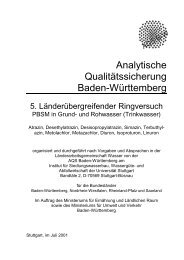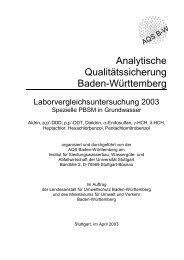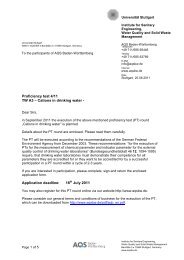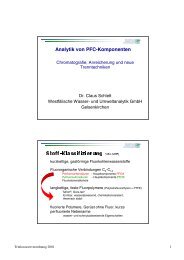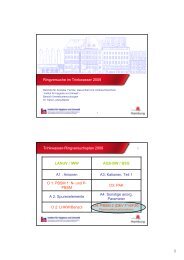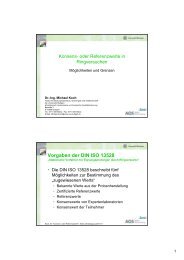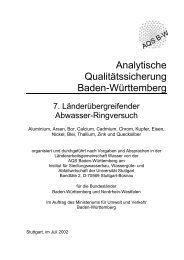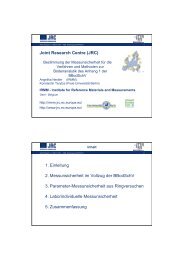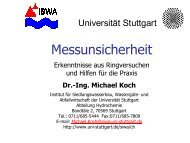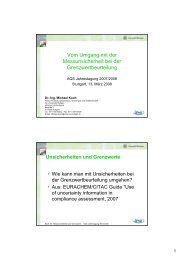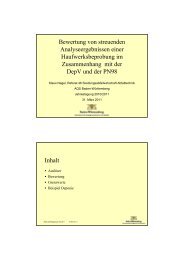Institute for Sanitary Engineering, Water Quality and Solid Waste ...
Institute for Sanitary Engineering, Water Quality and Solid Waste ...
Institute for Sanitary Engineering, Water Quality and Solid Waste ...
Create successful ePaper yourself
Turn your PDF publications into a flip-book with our unique Google optimized e-Paper software.
<strong>Waste</strong> <strong>Water</strong> Technology AWT<br />
Examinations to improve the hygienic river quality<br />
of the Koersch<br />
The determination of significant anthropogenic pollutions<br />
<strong>and</strong> the evaluation of their effects on the ecological<br />
current state of the surface water are an important<br />
part of the European Union water framework directive<br />
(2000/60/EG).The causes <strong>for</strong> poor quality (hygienic)<br />
of river water are mainly anthropogenic loads, first of<br />
all sewage discharges. These degrade the river water<br />
hygienic-biologically as well as optically (e.g. by foam<br />
<strong>for</strong>mation, sanitary products etc.).<br />
The Koersch is a small river south of the Stuttgart<br />
metropolitan area <strong>and</strong> an important inflow into the<br />
Neckar. It is significantly affected by anthropogenic<br />
sources, 2 wastewater treatment plants <strong>and</strong> 52 stormwater<br />
overflow tanks (only within the boarders of<br />
Stuttgart City). Under the scope of this research project<br />
microbiological examinations of the river Koersch,<br />
the discharges from certain stormwater overflow<br />
tanks <strong>and</strong> the two wastewater treatment plants Stuttgart-Moehringen<br />
<strong>and</strong> Stuttgart-Plieningen were to be<br />
carried out. The main objective of this investigation<br />
was to identify the major sources of pathogen entry<br />
into the river during both dry <strong>and</strong> rainy weather conditions.<br />
The results were then used to suggest technical<br />
measures to reduce the pathogen entry, as well as<br />
to simulate the polluting load.<br />
After the examination, the impact of the sewage became<br />
obvious during dry weather periods (discharges<br />
from the first wastewater treatment plant), as well as<br />
by rainy weather periods (discharges from the sewage<br />
overflow tanks). The concentrations of the pathogens<br />
in the river were higher at rainy weather than that at<br />
dry weather by 1 to 2 orders of magnitude.<br />
The results show that in addition to the effluents from<br />
wastewater treatment plants <strong>and</strong> stormwater overflow<br />
tanks, diffuse pollution is also a significant source of<br />
hygienic pollution of surface water. River sections were<br />
heavily burdened even without wastewater entry <strong>and</strong><br />
did not meet the requirements of the EU Bathing <strong>Water</strong><br />
Directive (2006/7/EC). Additionally, under dry weather<br />
conditions, wastewater treatment plants were responsible<br />
<strong>for</strong> high pathogen concentrations. Effluents from<br />
wastewater treatment plants with advanced treatment<br />
steps, such as s<strong>and</strong> filtration, resulted in some dilution<br />
of pathogen concentrations in rivers. However, the<br />
EU Bathing <strong>Water</strong> Directive criteria were still not met.<br />
During rainy weather conditions, the effluents from<br />
stormwater overflow tanks then produced peaks in the<br />
hygienic load in the rivers. Hence, the efficiency of advanced<br />
wastewater treatment steps is to be critically<br />
evaluated when a simultaneous reduction of diffuse<br />
pollution cannot be achieved.<br />
Figure: Escherichia coli concentrations of the Koersch as well as the confluences Steinbach <strong>and</strong> Ramsbach <strong>and</strong> the<br />
discharges of municipal wastewater at dry <strong>and</strong> rainy weather conditions<br />
27




